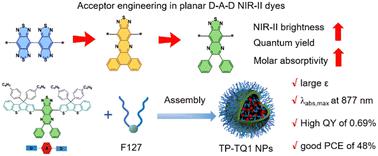当前位置:
X-MOL 学术
›
J. Mater. Chem. B
›
论文详情
Our official English website, www.x-mol.net, welcomes your feedback! (Note: you will need to create a separate account there.)
Planar-structured thiadiazoloquinoxaline-based NIR-II dye for tumor phototheranostics
Journal of Materials Chemistry B ( IF 7 ) Pub Date : 2024-03-29 , DOI: 10.1039/d4tb00302k Liangyu Zheng 1 , Ziqi Zhao 1 , Chun Xue 1 , Lei An 1 , Weidan Na 2 , Fan Gao 1 , Jinjun Shao 3 , Changjin Ou 1
Journal of Materials Chemistry B ( IF 7 ) Pub Date : 2024-03-29 , DOI: 10.1039/d4tb00302k Liangyu Zheng 1 , Ziqi Zhao 1 , Chun Xue 1 , Lei An 1 , Weidan Na 2 , Fan Gao 1 , Jinjun Shao 3 , Changjin Ou 1
Affiliation

|
Second near-infrared (NIR-II) fluorescence imaging shows huge application prospects in clinical disease diagnosis and surgical navigation, while it is still a big challenge to exploit high performance NIR-II dyes with long-wavelength absorption and high fluorescence quantum yield. Herein, based on planar π-conjugated donor–acceptor–donor systems, three NIR-II dyes (TP-DBBT, TP-TQ1, and TP-TQ2) were synthesized with bulk steric hindrance, and the influence of acceptor engineering on absorption/emission wavelengths, fluorescence efficiency and photothermal properties was systematically investigated. Compared with TP-DBBT and TP-TQ2, the TP-TQ1 based on 6,7-diphenyl-[1,2,5]thiadiazoloquinoxaline can well balance absorption/emission wavelengths, NIR-II fluorescence brightness and photothermal effects. And the TP-TQ1 nanoparticles (NPs) possess high absorption ability at a peak absorption of 877 nm, with a high relative quantum yield of 0.69% for large steric hindrance hampering the close π–π stacking interactions. Furthermore, the TP-TQ1 NPs show a desirable photothermal conversion efficiency of 48% and good compatibility. In vivo experiments demonstrate that the TP-TQ1 NPs can serve as a versatile theranostic agent for NIR-II fluorescence/photoacoustic imaging-guided tumor phototherapy. The molecular planarization strategy provides an approach for designing efficient NIR-II fluorophores with extending absorption/emission wavelength, high fluorescence brightness, and outstanding phototheranostic performance.
中文翻译:

用于肿瘤光治疗的基于噻二唑并喹喔啉的平面结构 NIR-II 染料
第二近红外(NIR-II)荧光成像在临床疾病诊断和手术导航中显示出巨大的应用前景,但开发具有长波长吸收和高荧光量子产率的高性能NIR-II染料仍然是一个巨大的挑战。在此,基于平面π-共轭供体-受体-供体系统,合成了三种具有体位阻的NIR-II染料(TP-DBBT、TP-TQ1和TP-TQ2),并研究了受体工程对吸收/吸收的影响。系统地研究了发射波长、荧光效率和光热性质。与TP-DBBT和TP-TQ2相比,基于6,7-二苯基-[1,2,5]噻二唑喹喔啉的TP-TQ1可以很好地平衡吸收/发射波长、NIR-II荧光亮度和光热效应。 TP-TQ1纳米粒子(NPs)在877 nm的峰值吸收处具有高吸收能力,对于阻碍紧密π-π堆积相互作用的大空间位阻,具有0.69%的高相对量子产率。此外,TP-TQ1 NPs表现出48%的理想光热转换效率和良好的相容性。体内实验表明,TP-TQ1 NP 可作为 NIR-II 荧光/光声成像引导肿瘤光疗的多功能治疗诊断剂。分子平坦化策略提供了一种设计高效 NIR-II 荧光团的方法,该荧光团具有扩展的吸收/发射波长、高荧光亮度和出色的光治疗性能。
更新日期:2024-03-29
中文翻译:

用于肿瘤光治疗的基于噻二唑并喹喔啉的平面结构 NIR-II 染料
第二近红外(NIR-II)荧光成像在临床疾病诊断和手术导航中显示出巨大的应用前景,但开发具有长波长吸收和高荧光量子产率的高性能NIR-II染料仍然是一个巨大的挑战。在此,基于平面π-共轭供体-受体-供体系统,合成了三种具有体位阻的NIR-II染料(TP-DBBT、TP-TQ1和TP-TQ2),并研究了受体工程对吸收/吸收的影响。系统地研究了发射波长、荧光效率和光热性质。与TP-DBBT和TP-TQ2相比,基于6,7-二苯基-[1,2,5]噻二唑喹喔啉的TP-TQ1可以很好地平衡吸收/发射波长、NIR-II荧光亮度和光热效应。 TP-TQ1纳米粒子(NPs)在877 nm的峰值吸收处具有高吸收能力,对于阻碍紧密π-π堆积相互作用的大空间位阻,具有0.69%的高相对量子产率。此外,TP-TQ1 NPs表现出48%的理想光热转换效率和良好的相容性。体内实验表明,TP-TQ1 NP 可作为 NIR-II 荧光/光声成像引导肿瘤光疗的多功能治疗诊断剂。分子平坦化策略提供了一种设计高效 NIR-II 荧光团的方法,该荧光团具有扩展的吸收/发射波长、高荧光亮度和出色的光治疗性能。



























 京公网安备 11010802027423号
京公网安备 11010802027423号